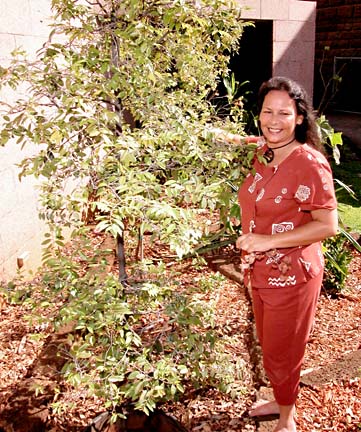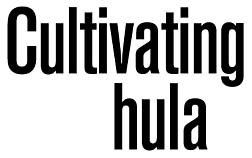
CRAIG T. KOJIMA / CKOJIMA@STARBULLETIN.COM
Noelani Kapuaakuni Tachera, project manager of the hula exhbit at the Bishop Museum, credits Heidi Lennstrom and Tommy Boyd for landscaping the Hula Garden.
Keep your eyes on the hands -- And the fern wristlets and anklets, as well as the lei. It all has meaning; nothing is left to chance in the dance of hula, nor the foliage that accompanies it. It's no coincidence, either, to Noelani Kapuaakuni Tachera, Cultural Education Specialist at Bishop Museum, that the opening of the "Hula: Dance of Poetry" exhibit and the Merrie Monarch Festival are within weeks of each other. Plants tied to hula are brought
Special activities
to fore in 'Dance of Poetry'
at the Bishop MuseumBy Ruby Mata-Viti
ruby@starbulletin.com"It so happened the (museum) space was open; we didn't plan it this way. But I think they planned it,' said Tachera, looking skyward. "I really do."
Maybe it is somewhat cosmic that this presentation, the first of its kind in the history of the Bishop Museum, according to Tachera, should open the same month as the 40th anniversary of the Big Island celebration named after the Hawaiian king who revived the dance.
Also well and more purposefully timed is the introduction of a hula garden that seems to welcome visitors at the entrance of the exhibit housed in the Harold K.L. Castle Memorial Building.
"Hula: Dance of Poetry," which opened Saturday, intertwines a historical perspective of hula with nature. Through artifacts, recordings, and interactive displays (you get to try on hula pa'u, for one), it takes observers on a journey along its evolution from cultural art form to entertainment, leading to the gentle balance of both that can be found today. Most who've seen the movements of a dancer can't help but be touched by aloha.
CRAIG T. KOJIMA / CKOJIMA@STARBULLETIN.COM
Hula dancers wear 'O'hia Lehua and fern, shown above, in hopes that their gift of the dance and celebration of life in it will blossom and grow.
And though the exhibit will be dismantled after June 1 for neighbor island showings and then to cities abroad, the garden will grace museum grounds long afterward.
A running theme inside and out is how hula is a manifestation of spirituality combined with nature, "one, hand in hand," as Tachera put it.
To the undiscerning eye, this might look like an ordinary decorative garden, yet to take shape, but the igloo-formed wire is a clue to forthcoming gourds used to make ipu, among other objects.
What has grown so far is coming in quite nicely, thanks to the landscaping talents and loving hands of Heidi Lennstrom and Tommy Boyd, said Tachera; and even in their early stages, plants familiar to those who know anything about the dance can be easily identified, such as kukui, fern, lau hala and 'o'hia lehua.
HUNDREDS OF PLANTS are connected with hula, but those that made the first cut for this tight plot of real estate were associated with kino lau ("tangible manifestations of hula deities who are honored by dancers and tradition") and then narrowed a final time.
STAR-BULLETIN / 1999
A dancer from Hula Halau O Kahikilaulani wears the head, wrist and anklet adornments specific to her kahiko performance.
"We chose plants that are (beloved by) the dancer as far as their adornments in kahiko."
This form of ancient hula is so serious, when dancers perform it, they don't dare smile. Just as with all hula, not only kahiko, every movement from head to toe is calculated and ripe with significance, and so are the types of plants the dancer uses for instrument, adornment and ho'okupu, gifts prepared as an offering to the deity on the altar (kuahu).
"Kinda deep," she said.
For instance, the kukui nut, used for medicine and as oil for light, represents the deities and enlightenment. For the dancer, it symbolizes their knowledge of the dance, passing the torch to keep the spirit of hula alive.
Tachera, a dancer for 35 years which includes time spent teaching this poetry in motion, seems to embody that light, pausing midsentence as if by reflex, to greet co-workers with a morning "aloha" whenever one passed by.
CRAIG T. KOJIMA / CKOJIMA@STARBULLETIN.COM
Gourds are used for ipu or ipu heke, left, and nose flutes, right.
As adornment, some plants such as the 'ohi'a lehua and palapalai and kupukupu fern are used to make lei po'o for the head ("ancestral connection; our head has a piko which connects us to our ancestors"); kuupe'e or wristlets ("so when they tell their story there's growth in perpetuating it") and anklets ("because they receive mana from the ground") and lei ("when you wear it you're inviting your ancestors to rest and visit with you as you dance").
The "voice" of the ipu, a percussion instrument made from the gourd, "talks to the dancers' feet," telling them by the rhythm the next move.
Because this is an island with limited resources, Tachera said another intent of the garden is to alert people of the need to protect and be responsible for our environment.
Most teachers or kumu hula are very conservation-conscious, she said, and now grow their own ferns and gourd for ipu, which until recently were being flown in from the mainland. "This way, they don't have to scavenge in the forests."
'Ie 'ie and 'a'ali'i plants give clue to condition of the forests, growing only in the oldest and healthiest ones.
CRAIG T. KOJIMA / CKOJIMA@STARBULLETIN.COM
Shown is ho'okupu or gift to the diety. Such gifts were left by dancers and those who came to take in the exhibit opening on Saturday.
AS THE DANCE evolves, so does the adornment and types of plants used. In the beginning, dancers wore pa'u, a cloth made from pounded mulberry bark, and used cordage to weave animal teeth together for anklets.
"Then missionaries arrived and said, 'You better cut that out, this is heathen, you're topless, this is not OK," said Tachera.
Frumpy cotton clothing covered the "heathens," and foliage was scrapped for more permanent materials forming earrings and other pieces of jewelry.
Although missionaries tried to suppress this cultural form, the exhibit pays homage to elders or kupuna who kept the tradition alive underground. This display inside the Castle building is in itself symbolic, with photographs of kupuna hung in two tunnel-like hallways, which might represent the hidden teachings. It connects the front, more cerebral, well-lighted portion of the exhibit to the back, comprising a spiritual display filled with an aura of nature.
CRAIG T. KOJIMA / CKOJIMA@STARBULLETIN.COM
Animal teeth and bone were first used in the ancient form of fhe dance, when the dancers work kapa cloth pa'u.
In the late 1800s, when King David Kalakaua brought the hula back, ti leaves are used as skirts because of their prevalence. Resourceful dancers have always used what is available.
The ti leaves were shredded, which gave them a grasslike appearance, but the notion of a grass skirt belongs only to tourists.
Kitschy cellophane skirts nevertheless have a place in hula history, matched with hapa-haole tunes as perhaps the only way the rest of the world could relate to the culture of that era, when the glitz of Hollywood costume was an acceptable form of showing skin.
Yet the Hollywood films of the '40s introduced hula to the rest of the world, which led others to research and resurrect its more stately form.
CRAIG T. KOJIMA / CKOJIMA@STARBULLETIN.COM
Pods of the 'a'ali'i poe were placed in the ipu of the uli uli, or rattle gourd.
Through this long history, sometimes adverse, the tradition has survived, adapting to many changes and pressures.
Yet one thing remains constant.
"Everything in hula has purpose," Tachera said. "Nothing is used because 'it looks so pretty.'" That perhaps is the one thing coincidental.
When: 9 a.m. to 5 p.m. daily through June 1 Hula: The Dance of Poetry
Where: Bishop Museum, Castle Building
Also: Every Sunday from now until June 1, the museum will feature a halau and hula-related activities involving lei making, shells and seed, ferns, and even making a nose flute, from noon to 12:45.p.m.
Call: 847-3511 for more information
The Hula Exhibit will close with the celebration of Music & Dance Festival, featuring hula performances.
Music & Dance Festival
When: 9 a.m. to 5 p.m., June 1
Where: Bishop Museum Great Lawn
Call: 847-3511
BACK TO TOP |
Special activities within the exhibit Hula to the max
Mondays, Wednesday and Fridays through June 1 >> Ola Na Moolelo (Living stories) on King Kalakaua being held in the Castle Building, first floor, 1:30 to 2 p.m. Viewers will be treated to a 20 minute presentation on the king and the challenges that lead to the end of monarchy.
Sundays through June 1 >> Hana Noeau (interactive activities) and featured halau activities in Castle Building, first floor, Sundays through June 1 noon to 12:45 p.m.
April 13 >> Featured halau Na Pualei O Liko Lehua
Kumu Hula Lein'ala Heine
April 20 >> No show due to Easter Sunday activities
April 27 >> Featured halau Joan S. Lindsey Hula Studio & Ka Pa Hula O Lilinoe
Kumu Hula Joan S. Lindsey & Lilinoe Lindsey
May 4 >> Seed and shell lei making with Melvin Lantaka
May 11 >> Featured halau Halau Hula O Hokulani
Kumu Hula Hokulani DeRego
May 18 >> Wili and haku making with Bill Char. Styles of lei making with fern.
May 25 >> Ohe hano ihu (Hawaiian flute) workshop with Calvin & Keliko Hoe
Click for online
calendars and events.








